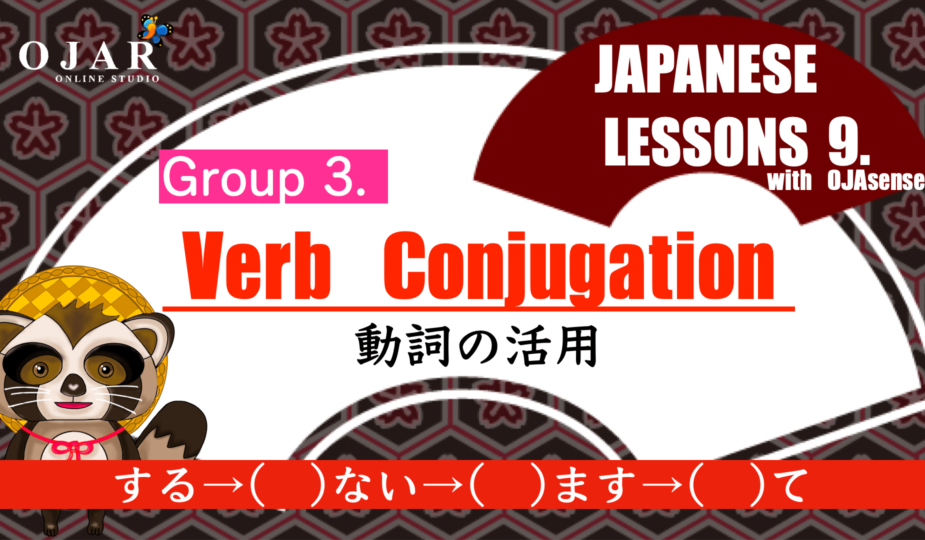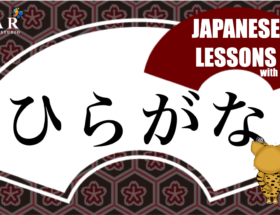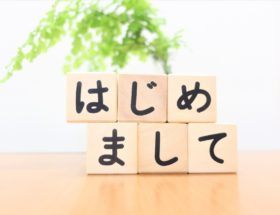Let’s learn verb conjugation this time too! Group 3 verb conjugations are “カ行変格活用 KAgyou-henkaku-katsuyou” and “サ行変格活用 SAgyou-henkaku-katsuyou”. I’m going to teach you the way of grammar which Japanese kids learn.
*I can’t perfectly apply the way because Japanese learners who don’t speak Japanese as mother tongue don’t have potential knowledge for Japanese.
A Dictionary of Basic Japanese Grammar
| Amazon Reviews: | ★★★★★ |
|---|
Publisher: JAPAN TIMES
CONTENTS
■Group 3 Verb
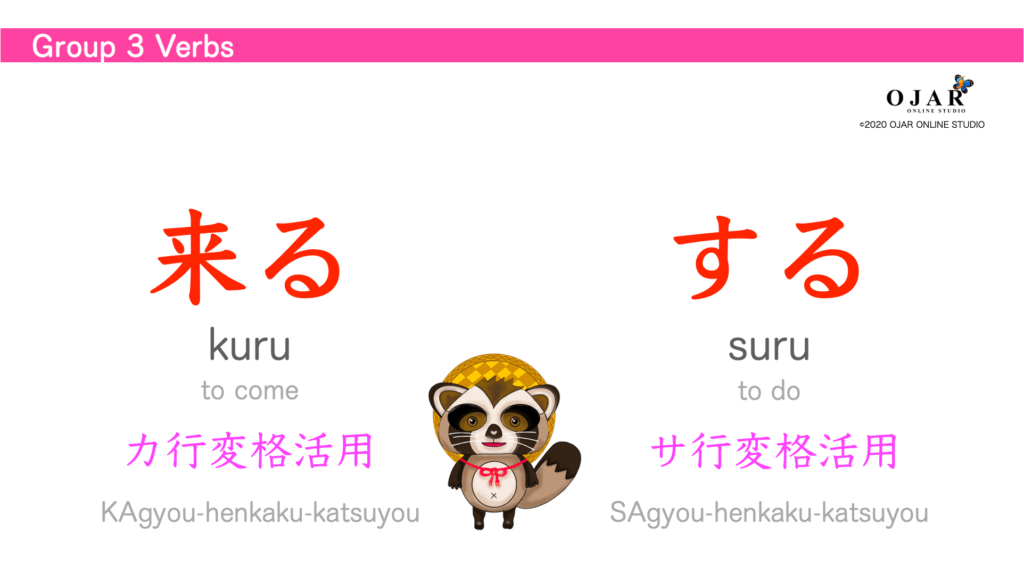
| カ行変格活用 | サ行変格活用 |
|---|---|
| KAgyou-henkaku-katsuyou | SAgyou-henkaku-katsuyou |
| 来る kuru to come | する suru to do |
Verb conjugations of Group 3 verb are ONLY 来る and する. So you need to memorize these conjugations. The verb of KAgyou-henkaku-katsuyou is 来る and the verb of SAgyou-henkaku-katsuyou is する. Japanese kids learn it in the age of 14 year-old as カ行変格活用 and サ行変格活用 in national language class. I have already gave the detail lesson in this article “How to Classify Verbs”.
Japanese people don’t usually use Group 3 verb in a Japanese class. Japanese learners only learn these verbs as jisho-form, masu-form, nai-form and te-form.
■ Forms
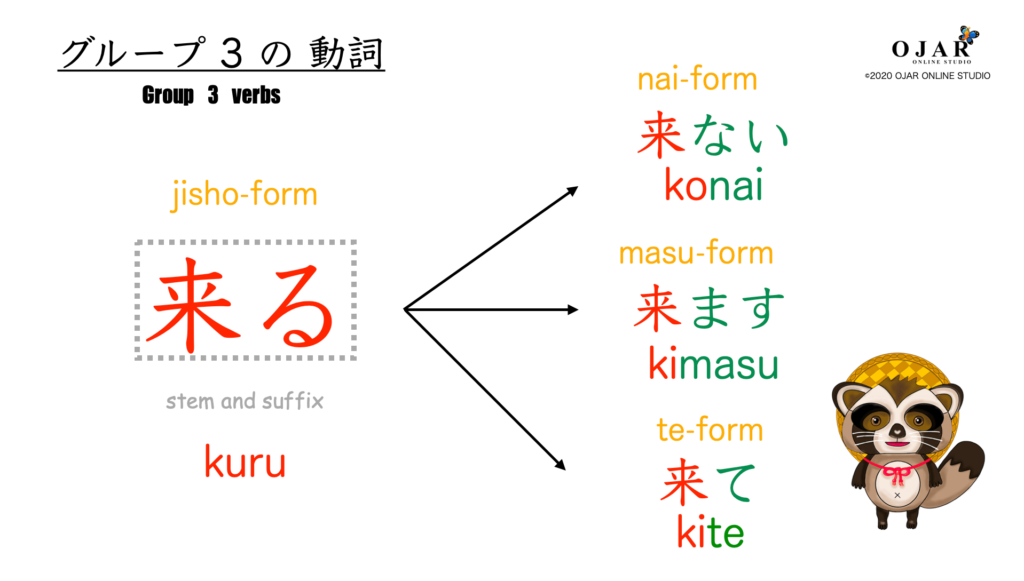
| 辞書形 jisho-form |
|---|
| “辞書形 jisho -form” appears in a dictionary. It’s like a “ to do” in English. When you learn verbs you need to learn this form the first definitely. |
| ない形 nai-form |
|---|
| “ない形 nai-form” conjugates to negative-form. It’s like a “not to do” in English. Japanese learners need to learn this form definitely. |
| ます形 masu-form |
|---|
| “ます形 masu-form” conjugates to polite-form. There is no expression in English. Japanese learners need to learn this form definitely. |
| て形 te-form |
|---|
| “て形 te-form” is used when the verb follows other adjectives or verbs. It corresponds to the grammar of English “An Infinitive” or “A gerund”. |
■ Verb Conjugation
The big difference between classifying verbs and Verb conjugation is; we focus on the sound before the suffix when we classify verbs and we focus on the suffix itself when we conjugate verbs.
| Form | English | Meaning | Following- conjugation |
|---|---|---|---|
| 語幹 gokan | stem | the part of a word taken off the ending | – |
| 未然形 mizen-kei | nai-form | the form for the thing’s happened not yet | ない う よう |
| 連用形 renyou-kei | masu-form / te-form | the form follows an adjective or a verb | ます た て |
| 終止形 shuushi-kei | jisho-form | the form ends with “。” | 。 |
| 連体形 rentai-kei | – | the form follows a noun | とき こと |
| 仮定形 katei-kei | – | the form for supposition | ば |
| 命令形 meirei-kei | imperative form | the form for imperative form | 命令 |
■ Following Other Words
| よう you |
|---|
| “よう you” are auxiliaries to make suggestions or offers. it’s same as “let’s” in English. |
| e.g. 日本語を 勉強しよう。 nihongo wo benkyou-shiyou Let’s study Japanese. |
| た ta |
|---|
| “た ta” are auxiliaries to make the past tense or the perfect tense. It’s same as “-ed” in English. |
| e.g. 今日 日本語を 勉強した。 kyou nihongo wo benkyoushita I studied Japanese today. |
| 終止形 shuushi-kei a conclusive form |
|---|
| “終止形 shuushi-kei a conclusive form” is “jisho-form a dictionary form”. It usually ends with “。読点 touten” which is same as “. period” in English. You can use it when you assert or itemize something. |
| e.g.僕は 教科書で 日本語を 勉強する。 boku wa hon de nihongo wo benkyousuru I study Japanese with textbooks. |
| とき toki |
|---|
| “とき toki” is a noun to make a sentence of the flow the time. It’s a same meaning of “when” as a conjunction in English. |
| e.g. 日本語を 勉強するとき、辞書を 使います。 nihongo wo benkyousuru toki jisho wo tsukaimasu I use a dictionary when I study Japanese. |
| こと koto |
|---|
| “こと koto” is a noun when you use a verb as a noun. It corresponds to the grammar of English “A gerund” of “-ing”. |
| e.g. 日本語を 勉強することは、楽しいです。 nihongoi wo benkyousuru koto wa tanoshii desu Studying Nihongo is fun. |
| ば ba |
|---|
| “ば ba” is a particle to make a sentence of introducing possible or impossible situations. It’s a same meaning of “if” as a conjunction in English. |
| e.g. 漢字を 勉強すれば、日本語が 上達します。 kanji wo benkyousure ba nihongo ga joutatsushimasu You can improve your Japanese if you learn kanji. |
| 命令形 meirei-kei imperative form |
|---|
| “命令形 meirei-kei imperative form” is used when you say “Do something.” or requests. |
| e.g.日本語を 勉強しろ。 nihongo wo benkyoushiro Study Japanese! |
■ The Classes of henkaku-katsuyou
The name of “変格活用 henkaku-katsuyou” conjugate irregularly. “カ行変格活用 KAgyou-henkaku-katsuyou” conjugates with “k- sound”, “サ行変格活用 SAgyou-henkaku-katsuyou” conjugates with “s- sound”.
1. KAgyou-henkaku-katsuyou
Let’s learn “カ行変格活用 KAgyou-henkaku-katsuyou” .
Here is the conjugation of “来る kuru to come”.
語幹:来る
活用語尾:来る
活用:カ行変格活用 KAgyou-henkaku-katsuyou
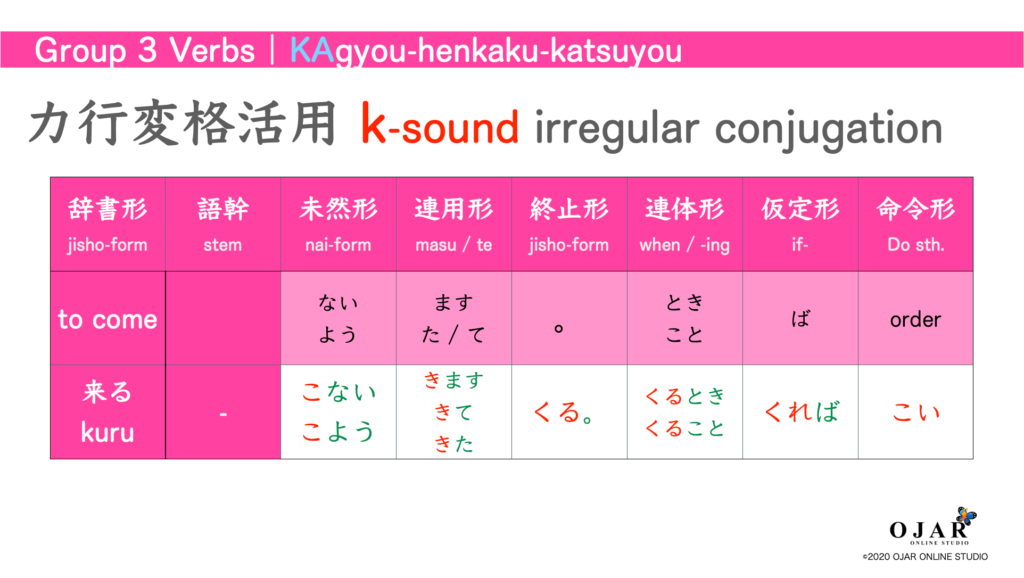
2. SAgyou-henkaku-katsuyou
Let’s learn “サ行変格活用 SAgyou-henkaku-katsuyou” .
Here is the conjugation of “する suru to do”.
語幹:する
活用語尾:する
活用:サ行変格活用 SAgyou-henkaku-katsuyou
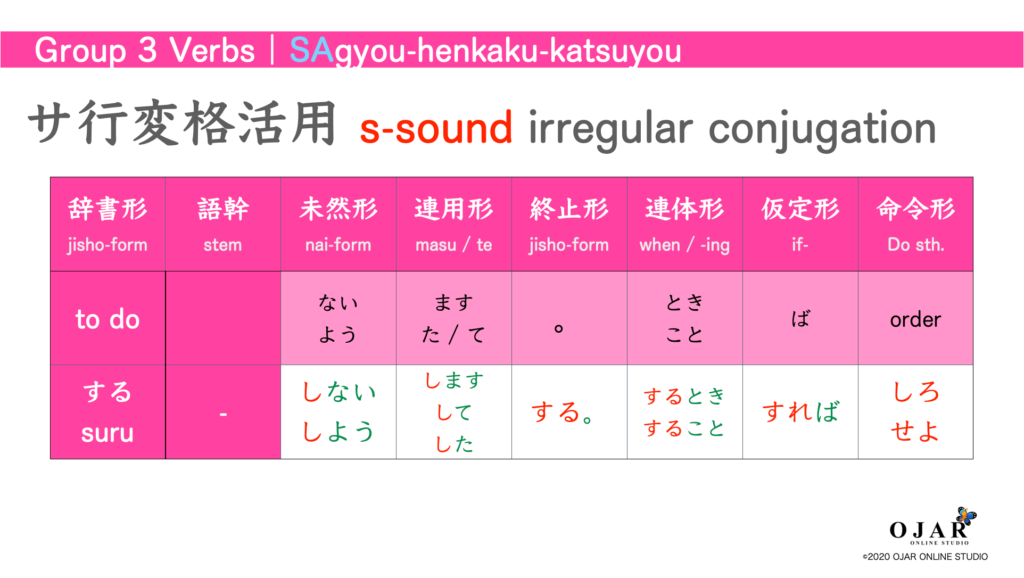
There are a lot of compound verbs with する below. If the suffix of the verb is “する”, you can conjugate with SAgyou-henkaku-katsuyou.
Beside,you can create verbs with する. For example, “ツイートする to tweet” and “ラインする to send a message on LINE”. These are created as slang words these days.
| 辞書形 jisho-form | 未然形 nai-form | 連用形 masu-form / te-form | 終止形 jisho-form | 連体形 rentai-kei | 仮定形 katei-kei | 命令形 order-form |
|---|---|---|---|---|---|---|
| 勉強する benkyousuru to study | 勉強しない 勉強しよう | 勉強します 勉強した 勉強して | 勉強する。 | 勉強するとき 勉強すること | 勉強すれば | 勉強しろ 勉強せよ |
| 理解する rikaisuru to understand | 理解しない 理解しよう | 理解します 理解した 理解して | 理解する。 | 理解するとき 理解すること | 理解すれば | 理解しろ 理解せよ |
| 準備する junbisuru to prepare | 準備しない 準備しよう | 準備します 準備した 準備して | 準備する。 | 準備するとき 準備すること | 準備すれば | 準備しろ 準備せよ |
| 掃除する soujisuru to clean | 掃除しない 掃除しよう | 掃除します 掃除した 掃除して | 掃除する。 | 掃除するとき 掃除すること | 掃除すれば | 掃除しろ 掃除せよ |
| 仕事する shigotosuru to work | 仕事しない 仕事しよう | 仕事します 仕事した 仕事して | 仕事する。 | 仕事するとき 仕事すること | 仕事すれば | 仕事しろ 仕事せよ |
| 電話する denwasuru to call | 電話しない 電話しよう | 電話します 電話した 電話して | 電話する。 | 電話するとき 電話すること | 電話すれば | 電話しろ 電話せよ |
| 買い物する kaimonosuru to go shopping | 買い物しない 買い物しよう | 買い物します 買い物した 買い物して | 買い物する。 | 買い物するとき 買い物すること | 買い物すれば | 買い物しろ 買い物せよ |
Group 3 Verb QUIZ
Homework
Conjugate these verbs in Japanese to the comment below!
①メールする to send a mail
②意味する to mean
③洗濯する to do laundry
Okay, that’s all for today!
Good luck with your Japanese study 😊
A Dictionary of Basic Japanese Grammar
| Amazon Reviews: | ★★★★★ |
|---|
Publisher: JAPAN TIMES
P.S. My English skill is not enough yet. Please correct me with DM from CONTACT if my English is wrong. Thank you for your cooperation!
Next Lesson is; CLICK HERE!
Japanese Lesson 18: te-form is Very Easy!
Previous Lesson is; CLICK HERE!
Japanese Lesson 17: Verb Conjugation Group 2

